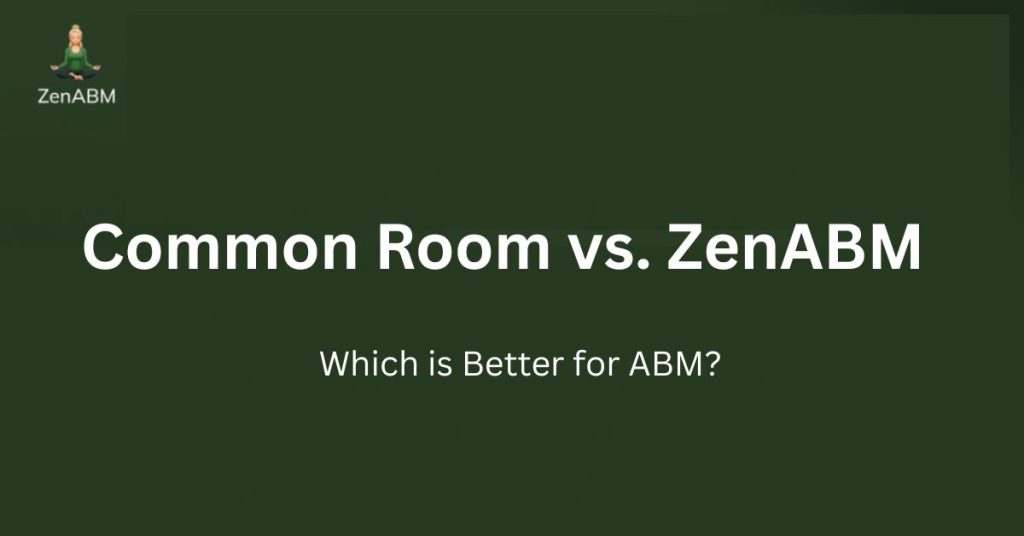In this article, I have compared Common Room vs. ZenABM based on their features, pricing, and ideal uses to help B2B marketing and sales teams decide which one fits their account-based marketing strategy (or if they might need both).
Read on…

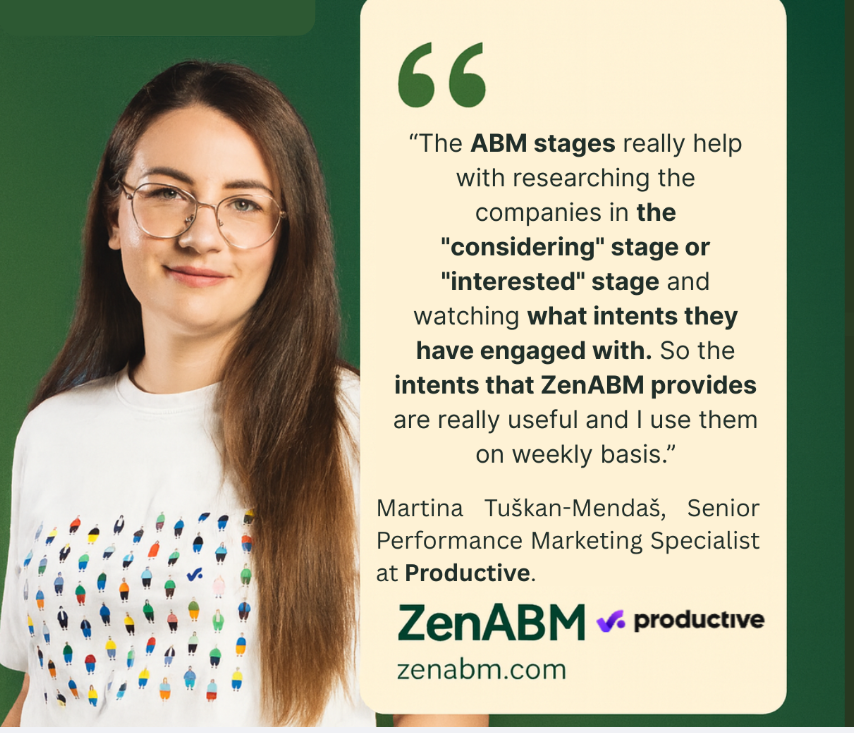
Common Room vs. ZenABM: Quick Summary
- Common Room is a multi-channel ABM and community intelligence platform that unifies data from 50+ sources like Slack, GitHub, G2, CRM, and website analytics.
- It’s person-centric, using AI (Person360™) for identity resolution, enrichment, and lead scoring across signals.
- Ideal for PLG or community-led B2B teams that want deep, people-level insights and workflow automation.
- ZenABM, in contrast, is LinkedIn-first, focusing on first-party ad engagement, qualitative intent, and real-time scoring.
- It helps lean marketing teams deanonymize LinkedIn ad viewers, track ABM stages, and prove ROI through plug-and-play revenue attribution dashboards.
- Common Room is suited for larger orgs with broad multi-touch ABM, while ZenABM fits startups and SMBs running focused LinkedIn-centric campaigns.
- Many enterprises may find value in using both: Common Room for multi-signal visibility and ZenABM for LinkedIn ad-to-pipeline attribution and LinkedIn-ad-specific intent tracking for target accounts.
Common Room Overview: Key Features, Pricing, and More
Common Room is a comprehensive customer intelligence and ABM platform that aggregates data from dozens of sources to give a 360° view of your prospects.
The name is indeed apt.
It’s a “common room” where signals from web traffic, product usage, community interactions, and more are unified into one place.
Plus, unlike most ABM tools, Common Room takes a completely person-centric approach.
Let’s look at its key features:
Massive Signal Integration
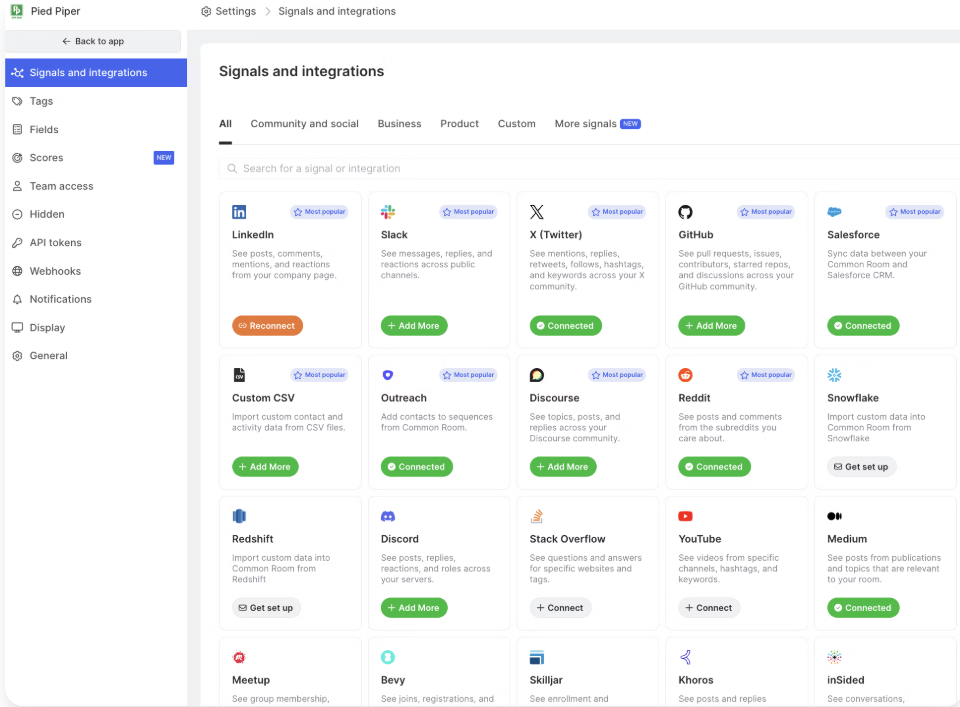
Common Room pulls in buying signals from 50+ native integrations across social media, community forums, CRM, product analytics, and more.
These include Slack, Discord, GitHub, LinkedIn, Twitter, Salesforce, HubSpot, Marketo, and even platforms like G2 and Stack Overflow.
All integrations are code-free, making it easy to connect your data sources.
AI-Powered Identity Resolution (Person360™)
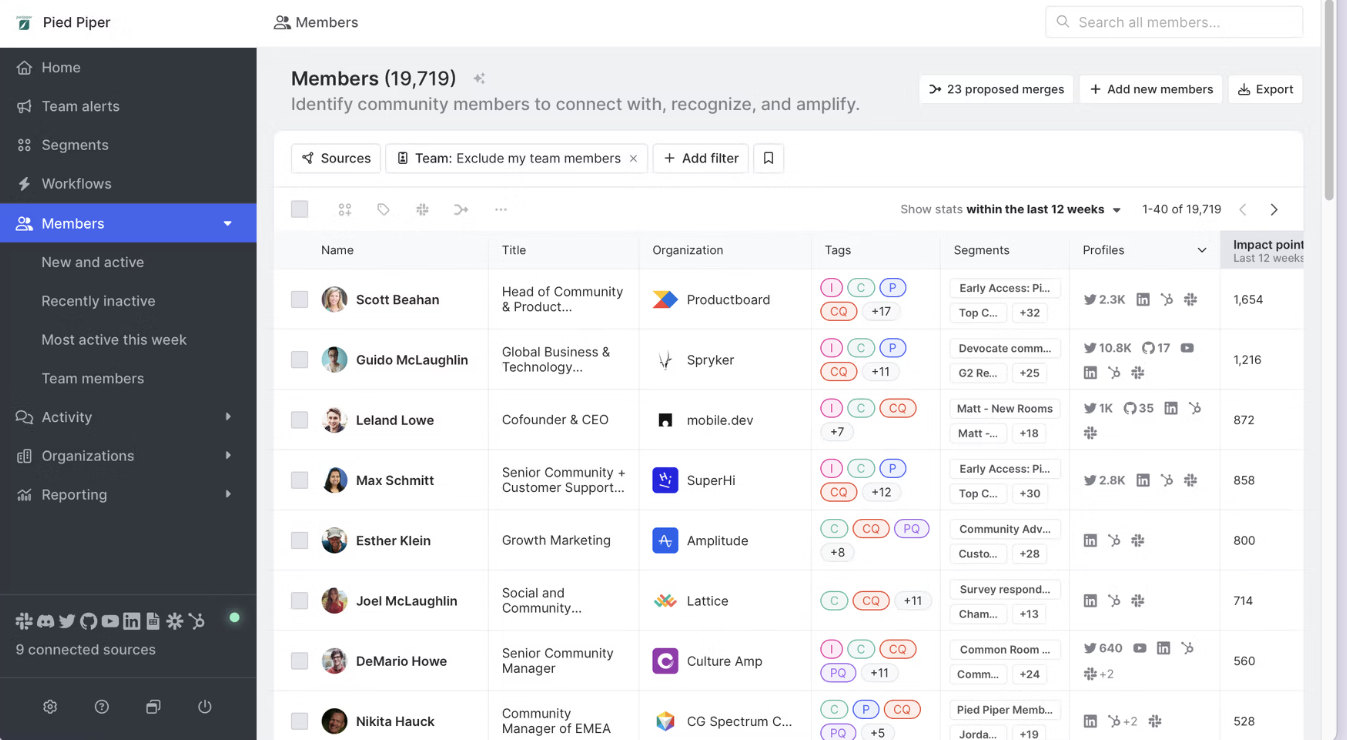
Once data flows in, Common Room’s Person360™ AI engine automatically merges activities into unified contact and account profiles.
It uses advanced matching (beyond simple email) to deduplicate and link identities across channels, flagging any uncertain matches for manual review. T
This creates a “single source of truth” for each lead.
For example, tying an anonymous website visitor to their Slack and GitHub persona once identified.
After identity resolution, a waterfall enrichment process kicks in: Common Room appends firmographic and technographic details (company size, industry, tech stack, etc.) from hundreds of data partners, with daily refreshes.
Lead & Account Scoring
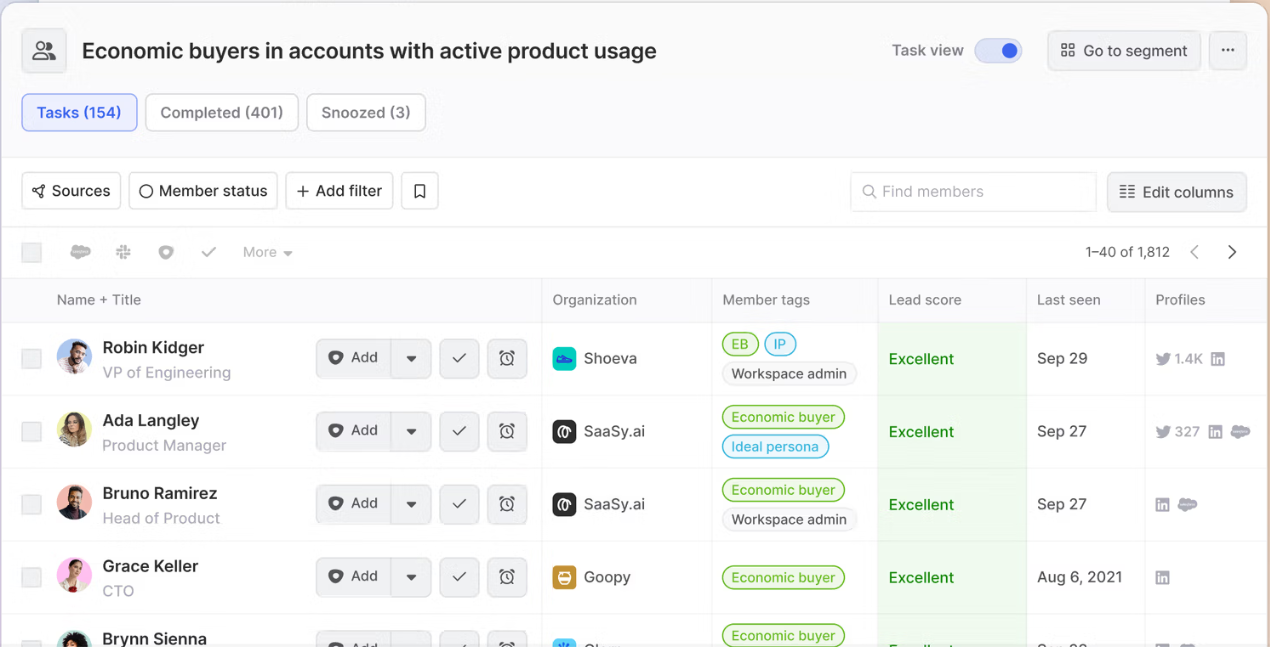
Common Room’s AI (nicknamed RoomieAI™) scores and filters leads based on fit and intent.
Users can define custom scoring models that combine any signals (e.g. job title seniority, product usage frequency, community posts) with firmographic criteria.
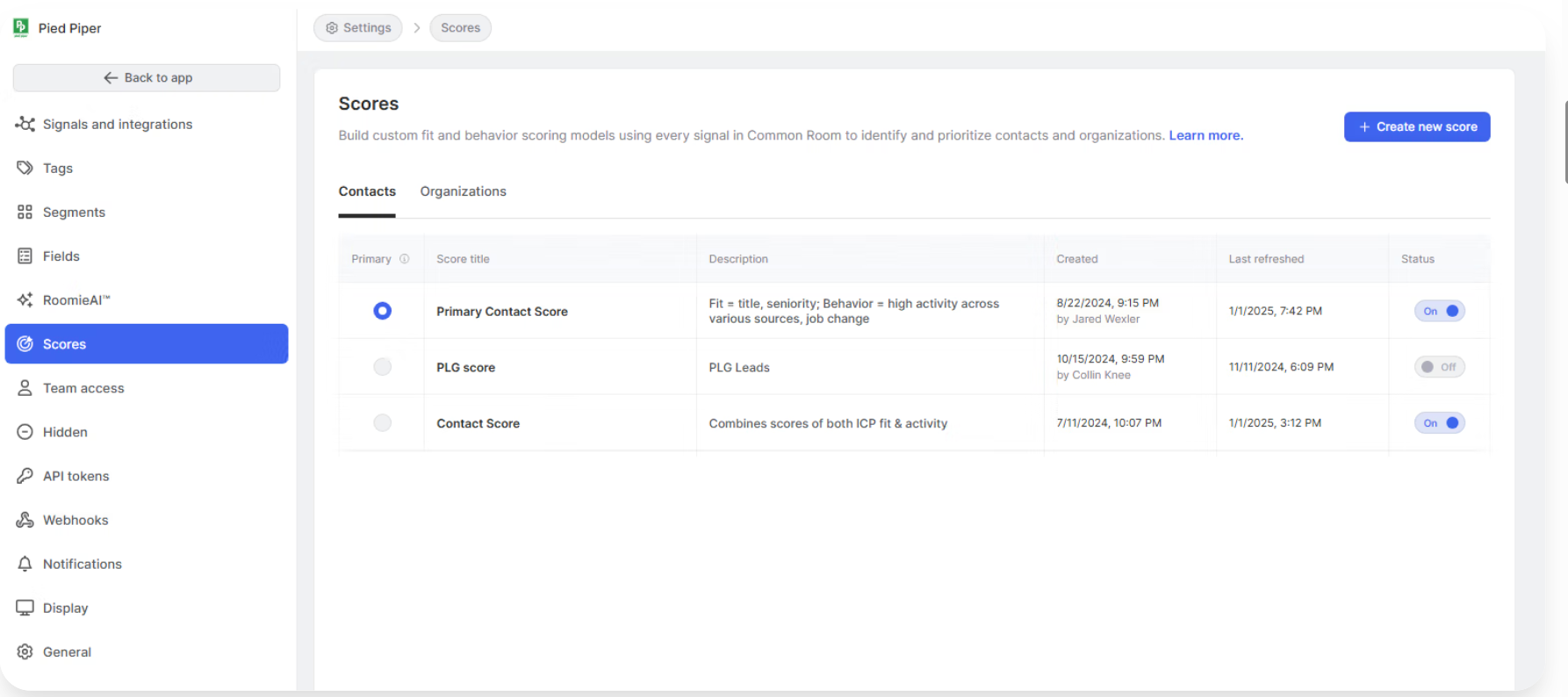
The platform supports hundreds of buying signals (everything from email opens and form fills to GitHub stars and G2 page visits) as inputs to the scoring engine.
These roll up into both contact-level and account-level scores, so sales teams get prioritized lists of high-fit, high-intent contacts.
For instance, Notion’s sales team uses Common Room to tag “high-fit” accounts and trigger Slack alerts whenever those accounts exhibit buying behavior.
Btw, ZenABM also helps with account scoring based on LinkedIn ad engagements:

So, if your ABM motion is LinkedIn-centric, you may want to give ZenABM a try.
Prospector Database
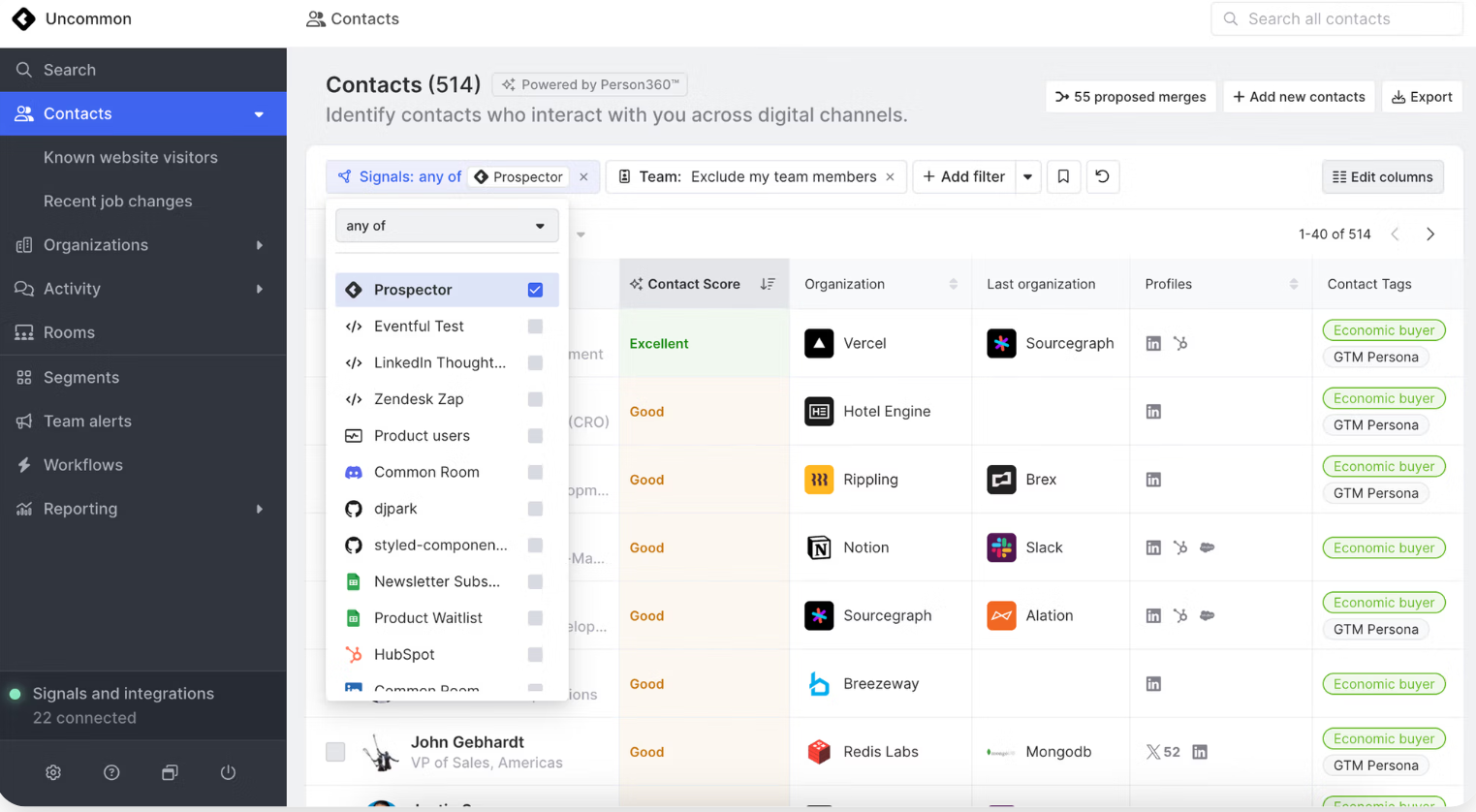
Going beyond your internal data, Common Room includes a prospecting tool tapping a 200M+ contacts database.
You can input your Ideal Customer Profile (ICP) filters (e.g. industry, role, company size) and Common Room will suggest new accounts and contacts that match, complete with scores based on third-party enrichment.
This helps expand your reach by finding lookalike prospects you might have missed.
Website Visitor Tracking
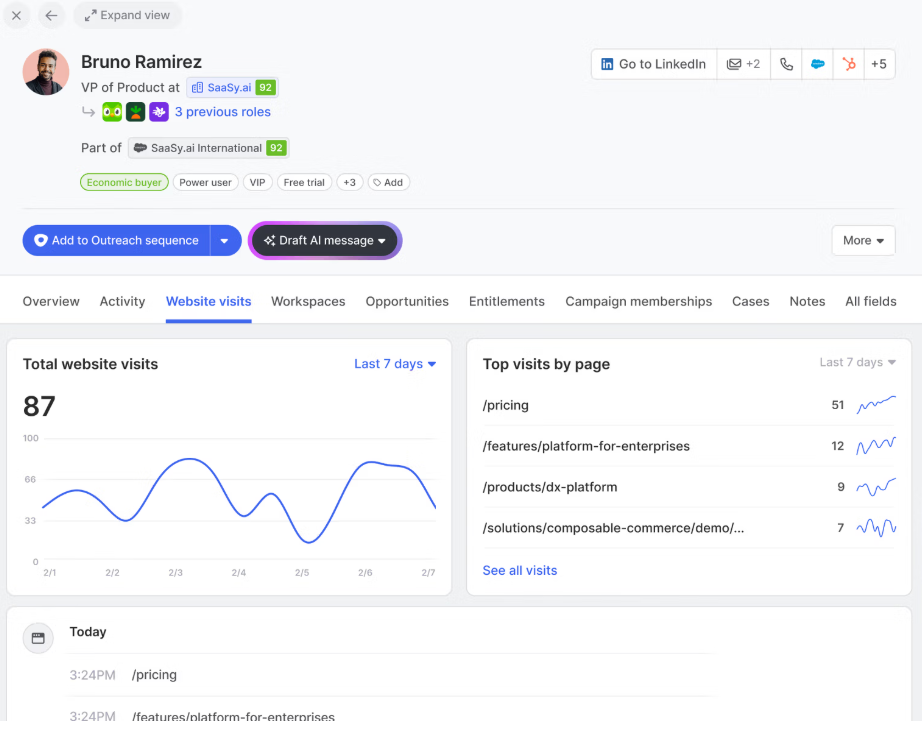
Common Room also identifies anonymous web traffic at the account level.
By using a first-party cookie and IP lookup, it can reveal which company a visitor is from (even if the individual isn’t yet known).
Once that visitor converts (fills a form or signs up), their historical page view activity is attached to their profile.
This means marketing can see if someone from a target account has been lurking on the pricing page or docs before they ever raise their hand.
Pro Tip: Roughly 42% (as one study found) is where IP lookup for website visitor deanonymization peaks in accuracy.

ZenABM suggests running low-cost LinkedIn text ads targeted at your website visitors as a way to reveal interested accounts.
Text ads on LinkedIn have very low click-through rates (so they’re inexpensive to serve), but ZenABM will show you which companies saw those ads frequently, meaning those companies’ employees likely visited your site’s key pages.
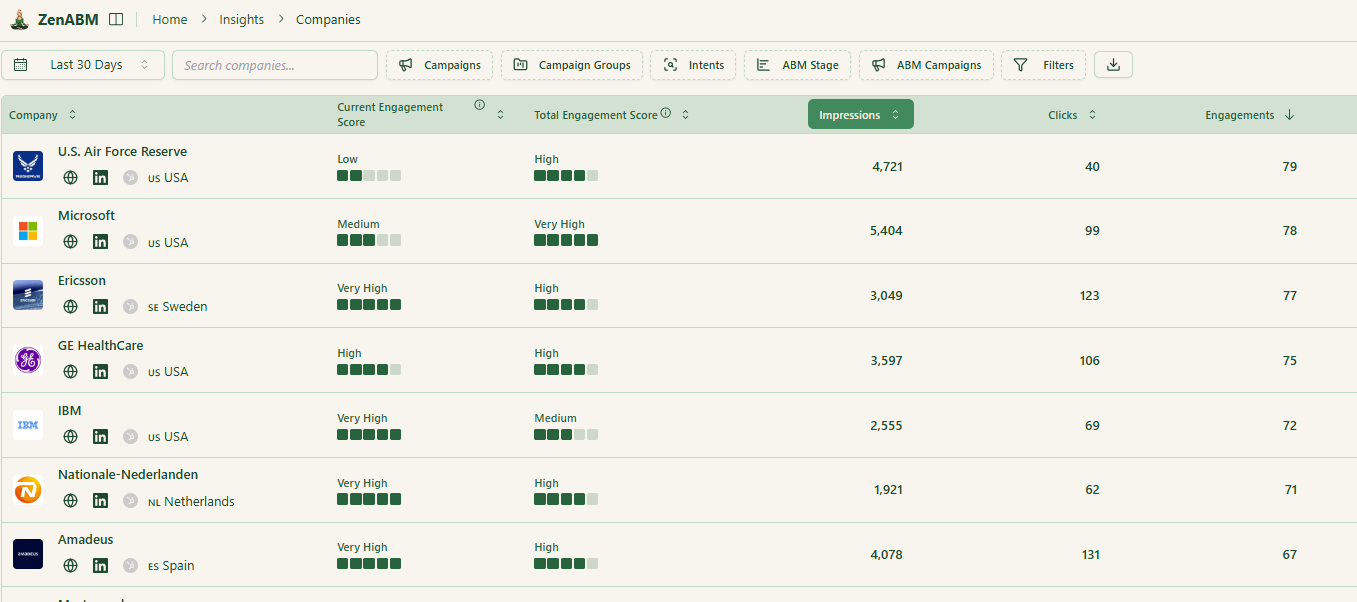
This first-party deanonymization tactic can identify engaged accounts more reliably than fuzzy IP matches and for almost free.


Community & “Dark Funnel” Insights
A standout feature of Common Room is its deep integration with community and developer channels – the so-called “dark funnel” where prospects engage before formal sales.
It links with Slack, Discord, Discourse forums, GitHub, Reddit, and more to surface meaningful activities.
For example, if an engineer at a target account asks a question on your community Slack or stars your GitHub repo, Common Room captures that and attributes it to the person and account.
Sales reps can then get notified and reach out in context.
E.g. “Saw you checked out our GitHub project; can I answer any questions?”
Workflow Automation and Alerts
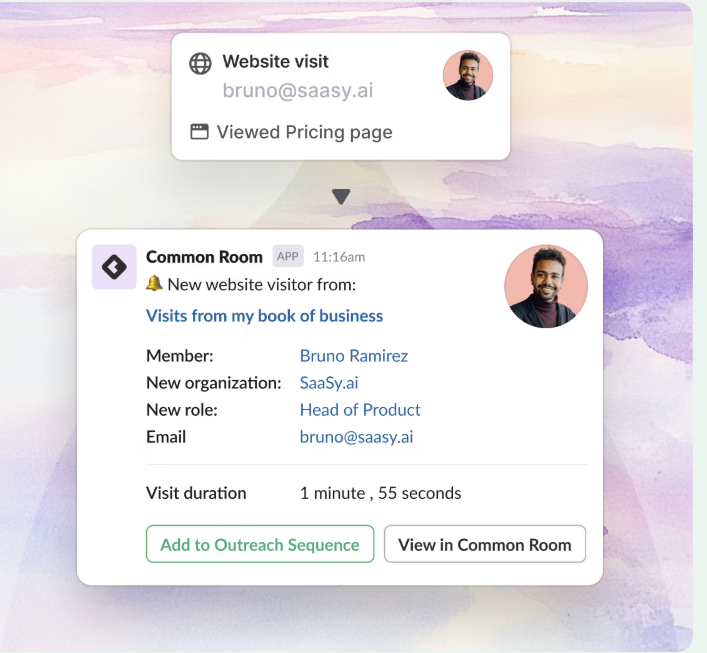
Common Room helps you act on all these insights with built-in automation.
Team Alerts let you set up real-time triggers.
There’s also a no-code workflow builder to create multi-step automation.
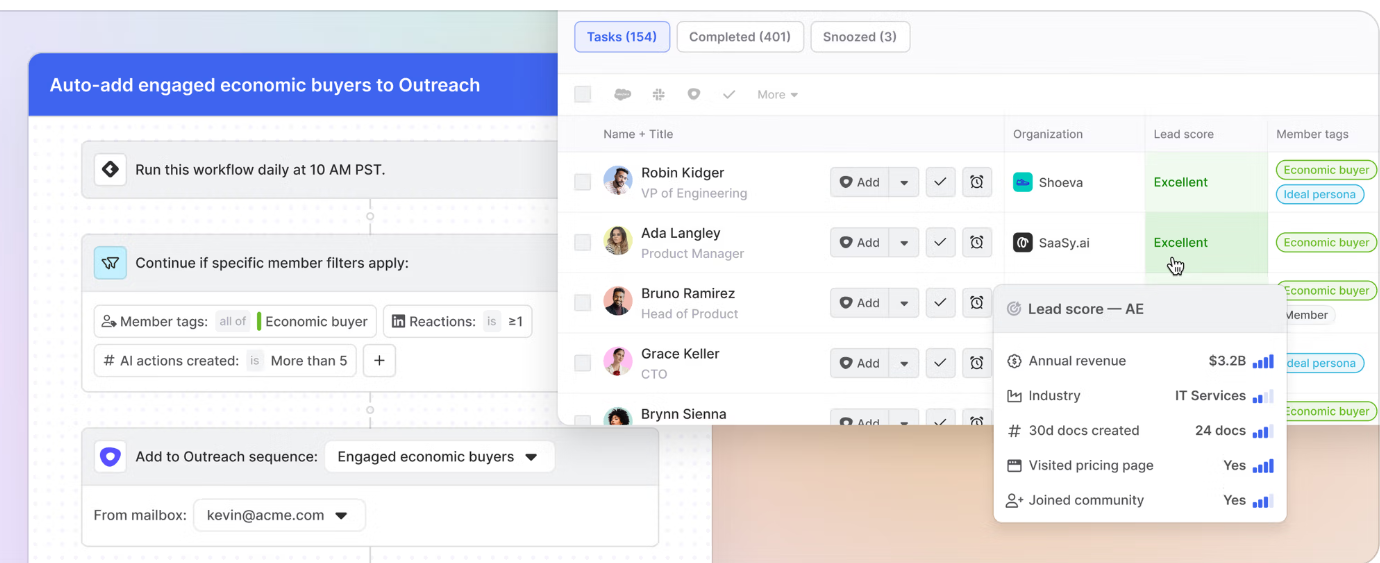
AI Outreach Assistant
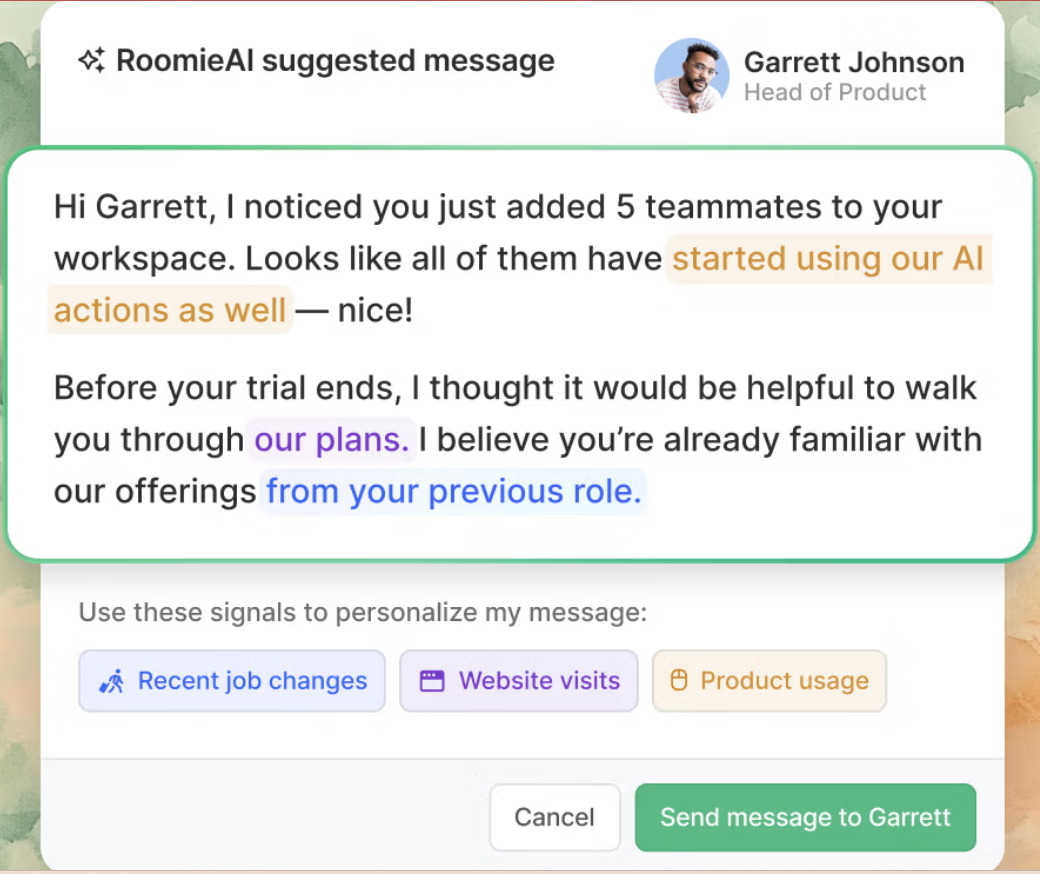
To complement its data intelligence, Common Room offers RoomieAI™ Activate .
It’s an AI writing assistant for sales emails.
It can generate personalized outreach messages based on the prospect’s specific signals and context.
Note: G2 shows that AI-generated messaging feature has received mixed feedback, with some users finding the output to be generic or lacking in personalization.
Integrations Ecosystem
Common Room natively connects to a vast array of tools in your stack, ensuring it slots into your workflow.
Its integration list spans CRMs (HubSpot, Salesforce), marketing and sales tools (Marketo, Outreach, 6sense, Demandbase, etc.), data warehouses (Snowflake, BigQuery), community platforms (Slack, Discord, InSided), and more.
For more details, you can visit Common Room’s Docs.
Common Room Pricing
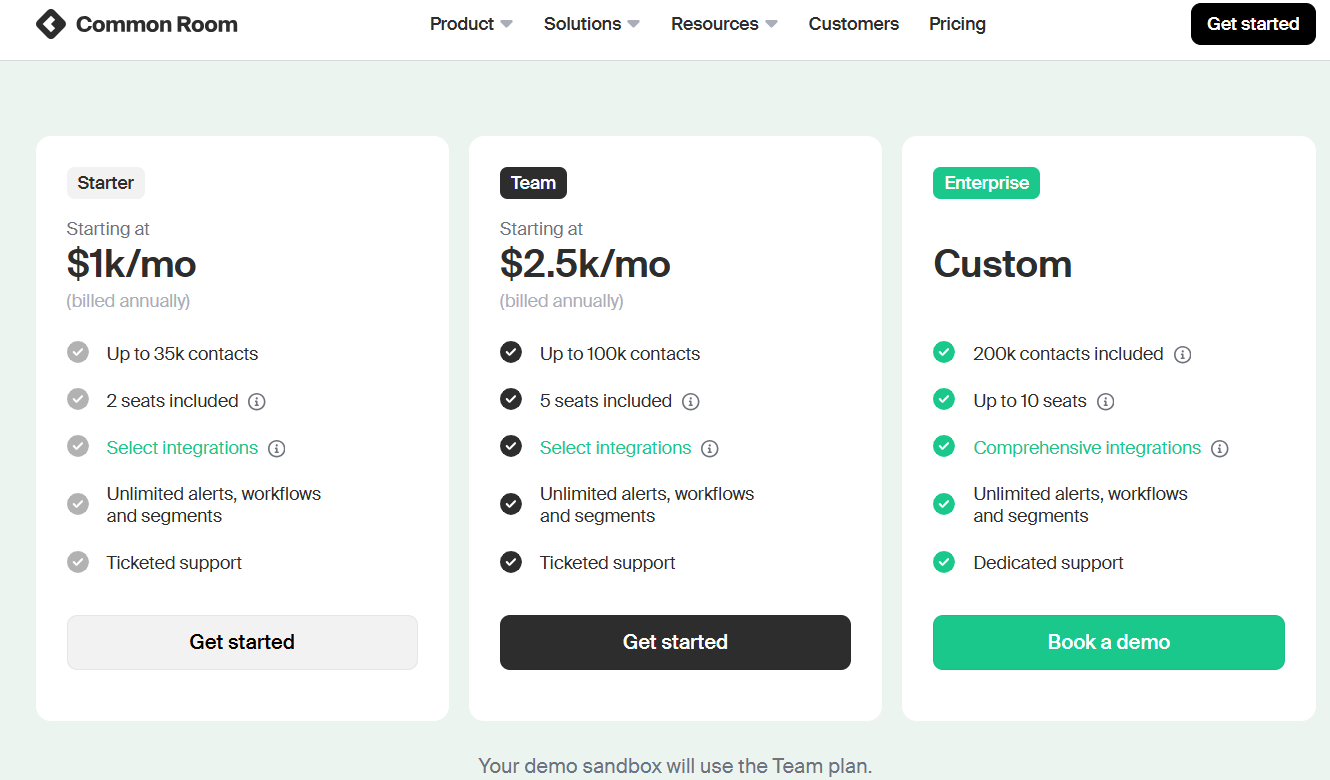
Common Room is a premium B2B product; pricing scales with contact volume and user seats.
The entry-level Starter plan (about $1,000/mo billed annually) includes ~35,000 tracked contacts and 2 user seats, plus basic integrations and unlimited alerts/workflows.
The mid-tier Team plan (around $2,500/mo) raises limits to ~100,000 contacts and 5 seats.
Both tiers include most core features (visitor tracking, Person360 enrichment, workflow automation, etc.).
An Enterprise plan (custom pricing) accommodates ~200K+ contacts, 10+ seats, and adds all advanced integrations (e.g. full Salesforce data sync, custom objects) and dedicated support.
Also, a free trial is available on the Team tier (no credit card).
ZenABM Overview: Key Features, Pricing, and More
ZenABM takes a very different approach to ABM.
Instead of boiling the ocean of every possible signal, ZenABM doubles down on one powerful channel: LinkedIn.
It’s a “LinkedIn-first, first-party” ABM platform designed to bridge the gap between your LinkedIn Ads campaigns and your sales pipeline.
First-Party LinkedIn Ad Engagement Tracking

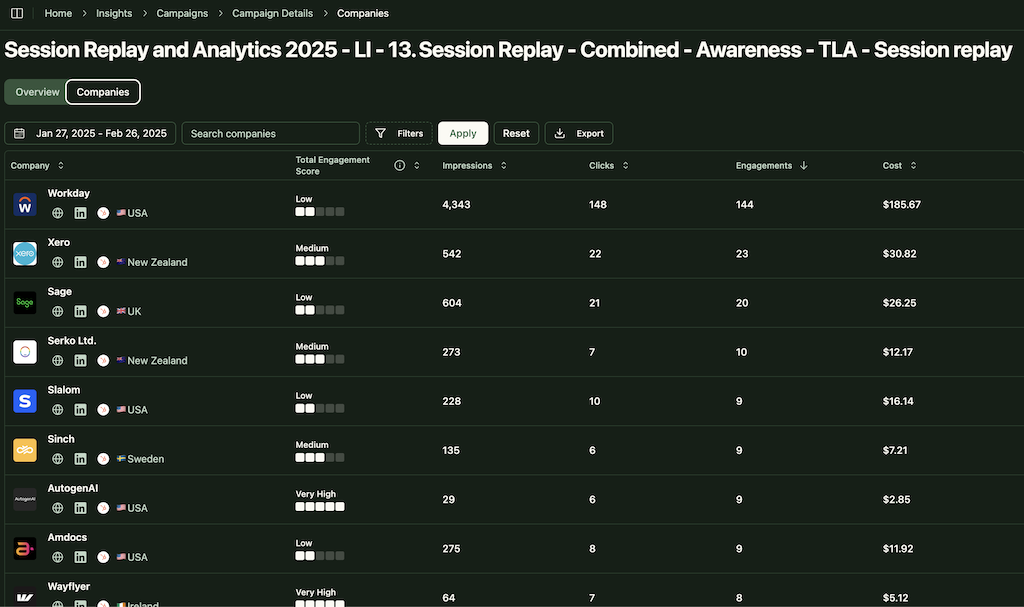
ZenABM connects directly to the LinkedIn Marketing API (using no scraping, cookies, or workarounds) to pull company-level ad engagement data for your campaigns.
It means when you run LinkedIn ads targeting a list of accounts, ZenABM can tell you, for each account, how many impressions and clicks they had.
Traditional ABM platforms often struggle to provide this granularity on LinkedIn because they rely on third-party data or complex pixel matching.
Real-Time Account Intent Scoring
ZenABM layers on an engagement scoring model that gauges each account’s intent and interest level based on their recent LinkedIn interactions.
For example, if Account X has clicked your ads this week frequently, ZenABM will boost that account’s score and mark it as “hot.”
The scoring considers both current engagement and historical engagement, ensuring you know not just who engaged once, but who is consistently interested.

This helps sales prioritize outreach: your BDRs can focus on the accounts with the highest engagement scores, indicating strong intent.
One digital marketer on Reddit noted that getting this campaign engagement data out of LinkedIn via ZenABM was a “game changer,” allowing their team to see which content/offer/persona combinations drive the most pipeline and optimizing campaigns accordingly.
They achieved roughly $18 in pipeline per $1 of ad spend after iterating with these insights!
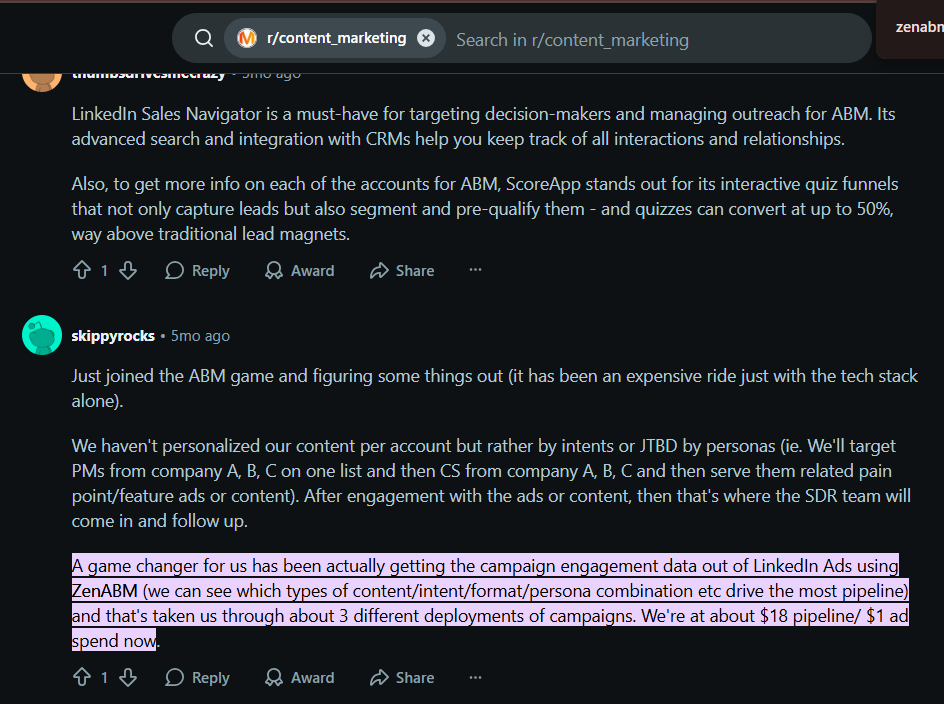
ABM Stage Tracking

ZenABM enables you to define your ABM funnel stages (e.g., Identified → Aware → Engaged → Interested → Opportunity) and automatically classifies accounts using engagement and CRM information.
You can set your own thresholds for “Engaged” or “Interested,” and ZenABM will track stage transitions automatically.
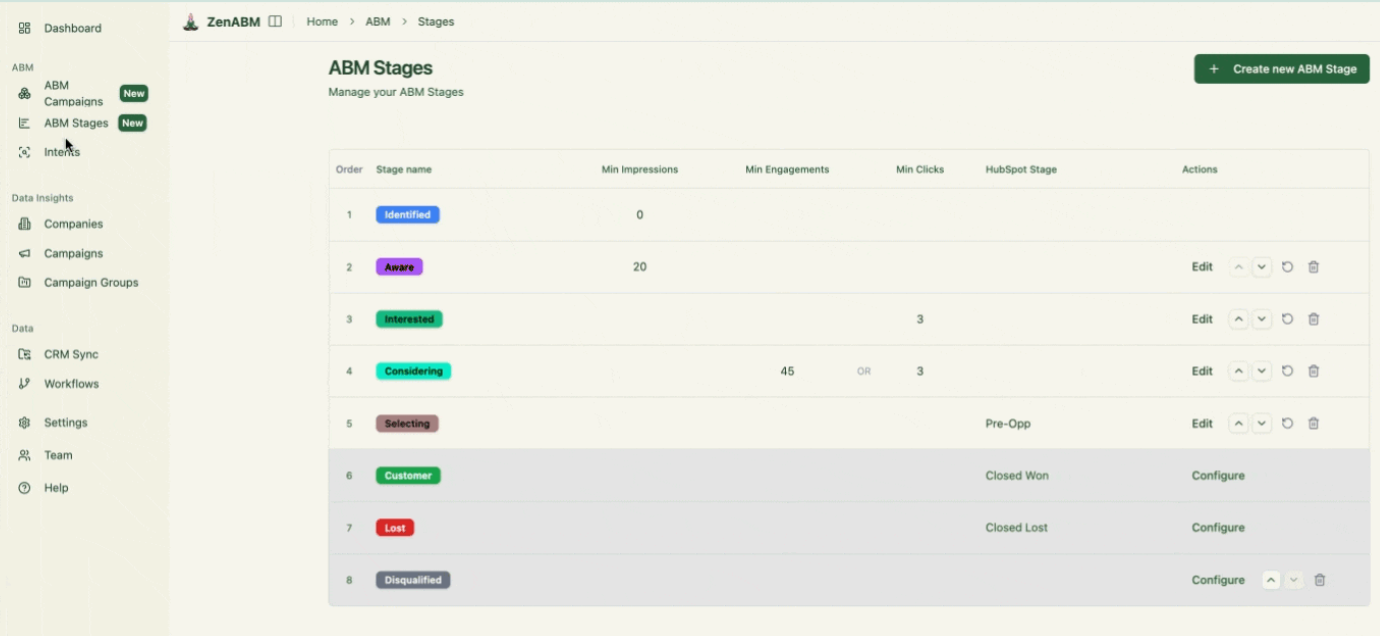
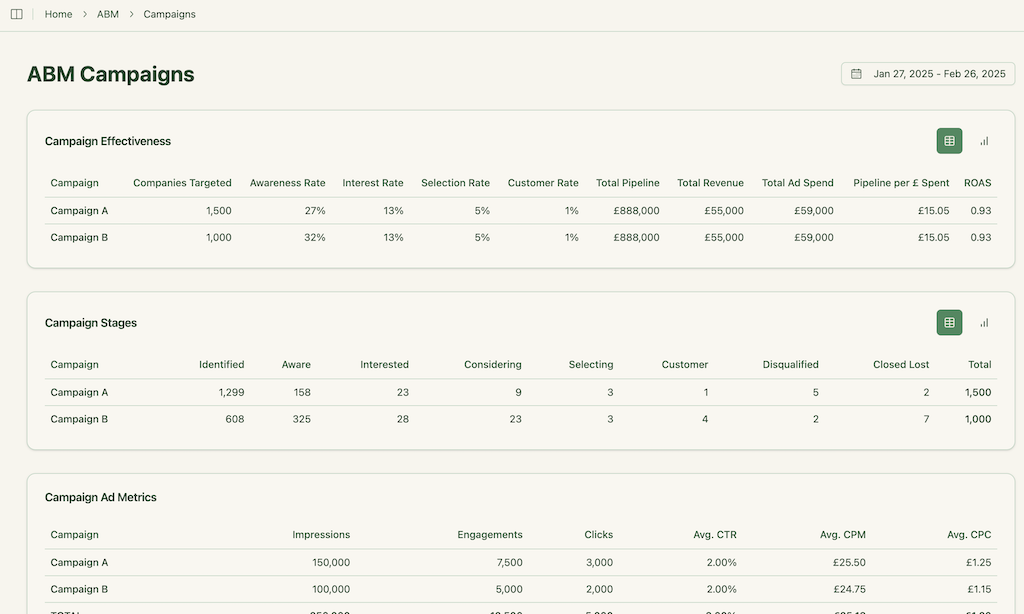
This delivers full-funnel visibility like enterprise ABM platforms, highlighting where accounts stall and where progress accelerates.
CRM Integration and Workflows
ZenABM integrates bidirectionally with CRMs such as HubSpot (Salesforce available on higher plans).
LinkedIn engagement data feeds directly into your CRM as company-level properties, keeping sales teams informed:
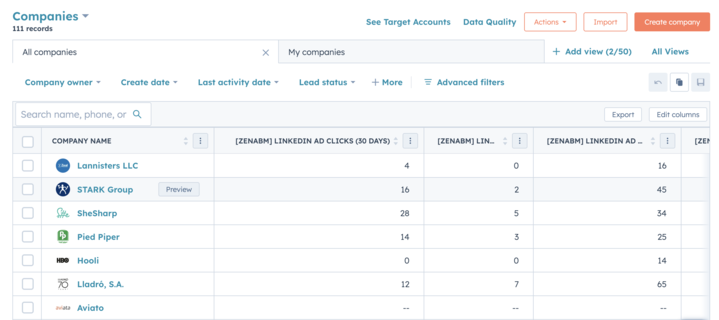
ZenABM can auto-update account stages to “Interested” when engagement passes a set threshold and assign accounts to specific BDRs for follow-up.

Intent Tagging from LinkedIn Ads Engagement
ZenABM allows you to tag campaigns by theme (like “Feature A” vs. “Feature B”) and shows which accounts engage with which themes, revealing their priorities.
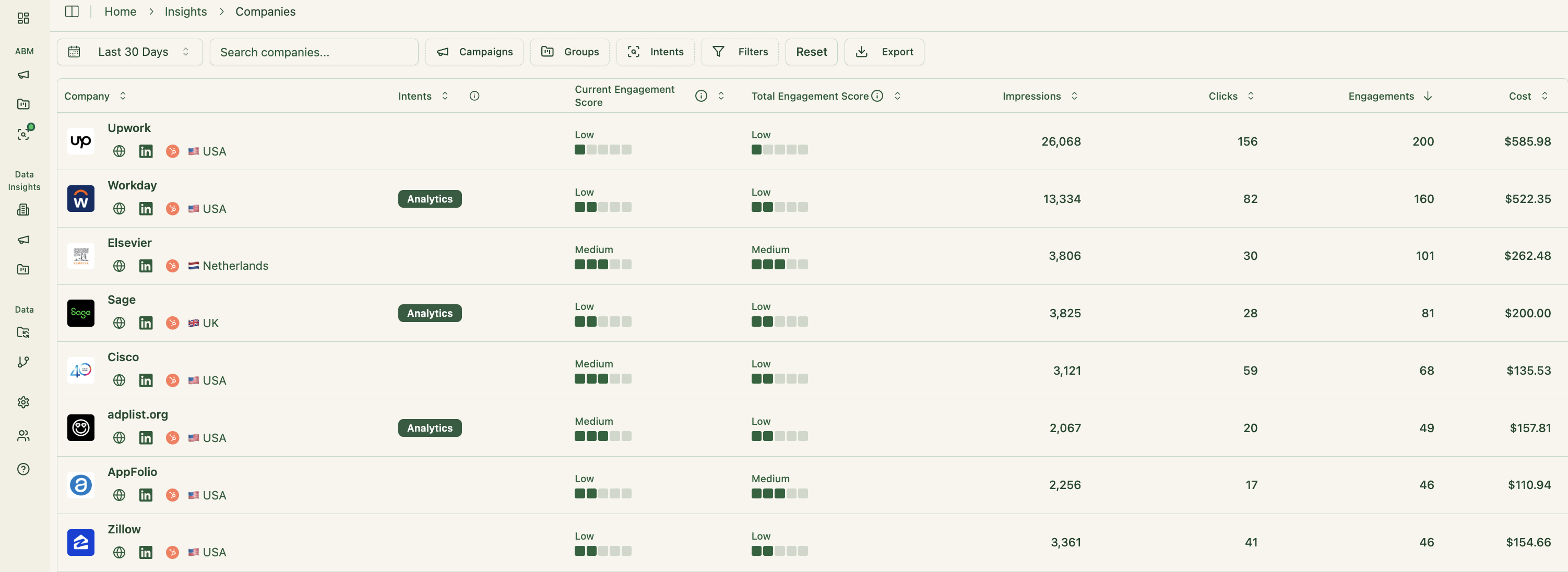
This is genuine first-party intent. Instead of paying Common Room or another platform for inferred keyword interest, you get direct proof like Account Z clicking “Feature A” ads, demonstrating actual buying interest.
These insights also sync to your CRM, supporting highly targeted outreach and relevant messaging.
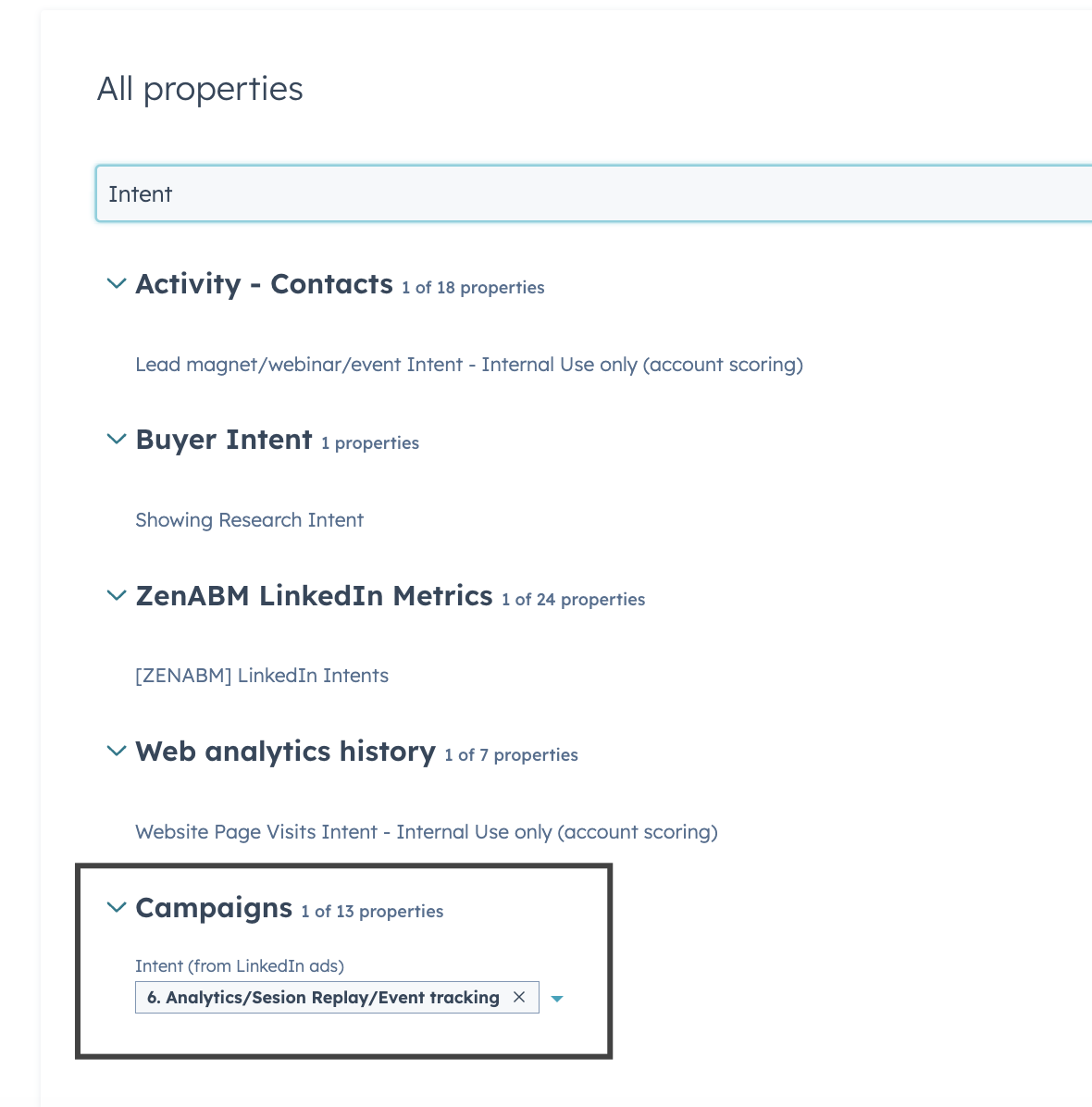
Your sales reps can instantly see which topics or pain points each account reacts to most.
Built-in Dashboards and ABM Analytics
ZenABM includes pre-built ABM dashboards linking ad exposure, engagement, funnel stages, and pipeline metrics.
- Track performance across campaigns, LinkedIn groups, and individual ads:
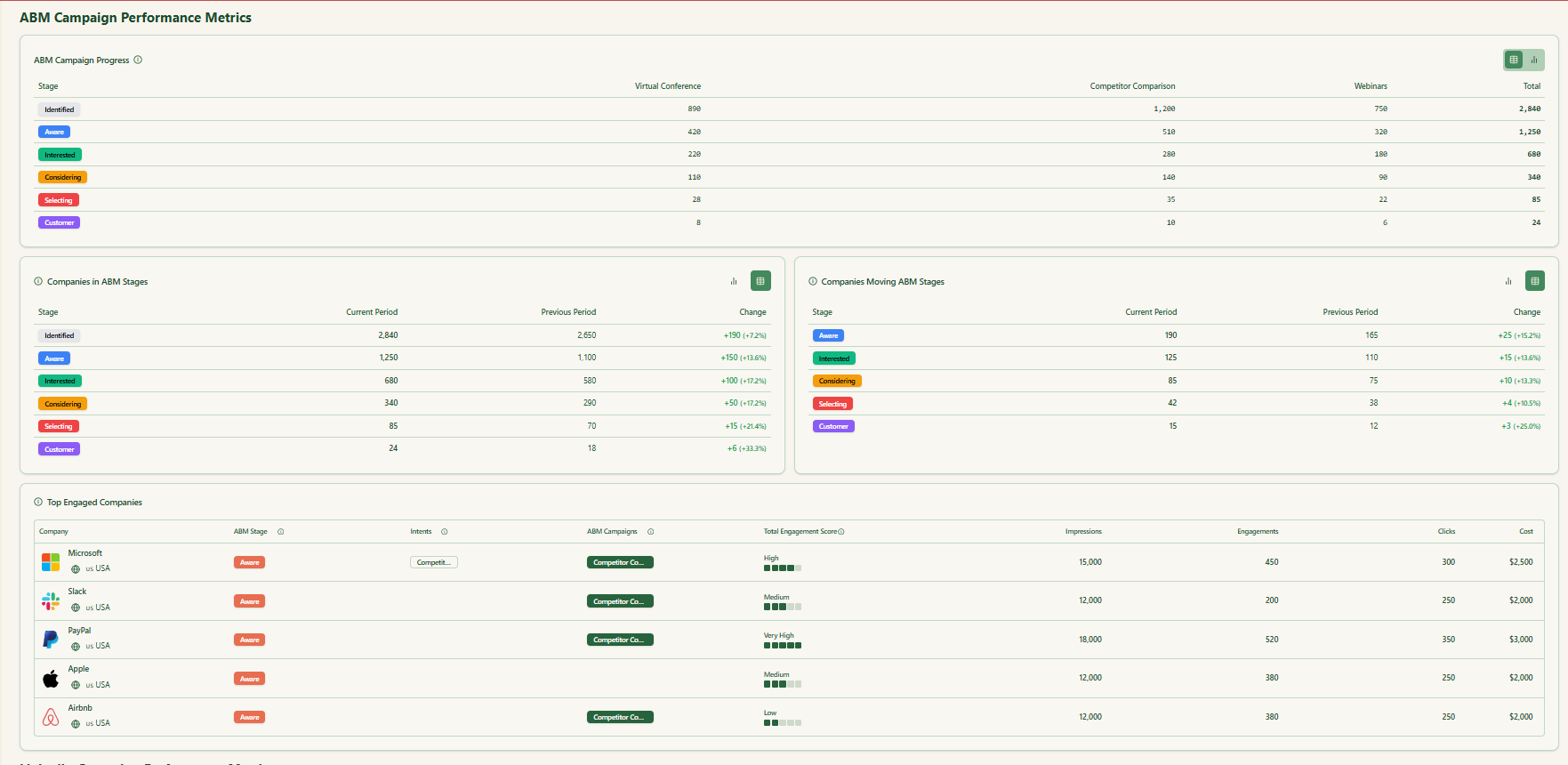

- ZenABM tracks both deal size and ad spend per account/campaign, enabling ROAS, pipeline per dollar, and campaign-driven revenue insights. Revenue teams can use this to optimize engagement and accelerate deal closure rather than focusing on vanity metrics

ZenABM Pricing
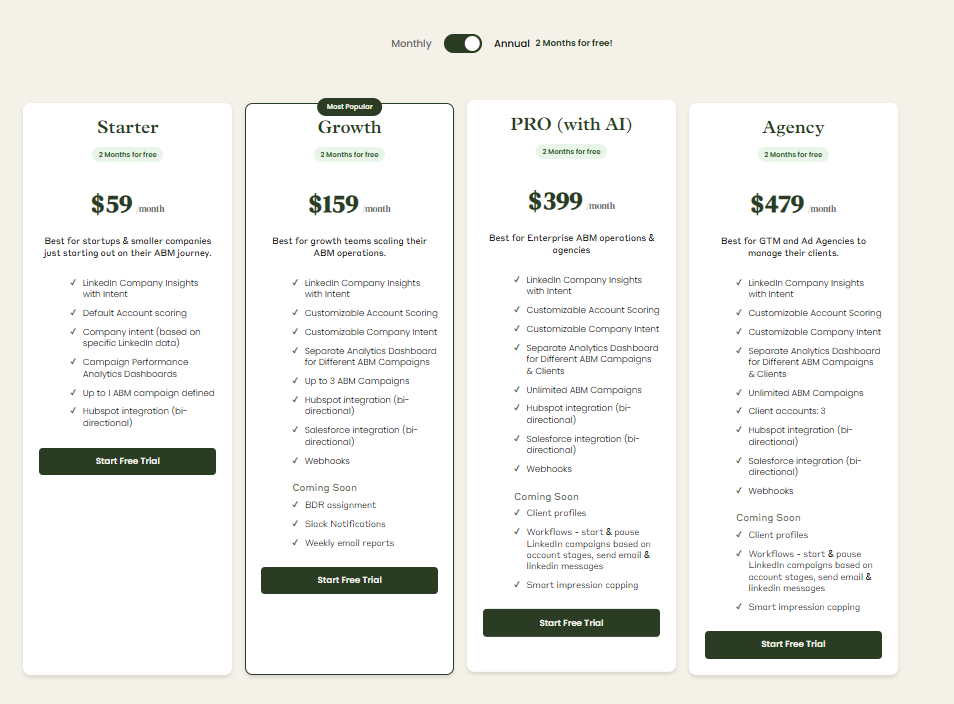
Plans start at $59/month for Starter, $159/month for Growth, $399/month for the Pro (AI) tier, and $479/month for the agency tier.
Even the highest tier costs under $7,000/year, far less than Common Room.
All plans cover essential LinkedIn ABM functions, with higher tiers mostly expanding limits or adding Salesforce integration.
Pricing is flexible (monthly or annual with two months free), and a 37-day free trial allows teams to try before buying.
Common Room vs. ZenABM: Key Differences
Here’s a table listing out the key differences between Common Room and ZenABM:
| Aspect | Common Room | ZenABM |
|---|---|---|
| Data Focus | Multi-source, person-level signals from 50+ channels (Slack, GitHub, G2, CRM, website, etc.) | LinkedIn-first, account-level intent (which company X engaged with which ad) |
| ABM Approach | “Land & expand” / community-driven ABM based on diverse engagement signals | “Target & engage” LinkedIn-driven ABM optimized for ad → pipeline workflows |
| Ad Campaign Tracking | No native ad analytics; relies on integrations for paid attribution | Native LinkedIn Ads tracking: impressions, clicks, qualitative intent, pipeline attribution |
| User Experience | Feature-rich with an onboarding curve but powerful for ops teams | Plug-and-play; quick setup (connect LinkedIn + CRM and go) |
| Integrations | 50+ integrations across community, CRM, data warehouses, analytics | Focused integrations: LinkedIn, HubSpot, Salesforce, ad data |
| Ideal For | PLG, DevRel, community-driven ABM and large GTM teams | Anyone running LinkedIn-centric ABM or requiring a simple yet effective LinkedIn ABM orchestration and attribution tool. |
| Key Differentiator | Deep person-level context across many ecosystems | Qualitative, first-party LinkedIn ad intent + ad-to-pipeline attribution |
So, Which is Better for Account-Based Marketing?
The natural question after dissecting these two tools is: which one is better for ABM?
The truth is, it depends:
- Choose Common Room if you are aiming for a broad, multi-channel ABM strategy that involves nurturing prospects across various touchpoints (community, content, product trials, etc.), and you need a centralized intelligence layer to make sense of it all. The Common Room is an excellent choice for companies with active user communities or developer ecosystems, where engagement may begin in a Slack group or GitHub repository long before a formal sales conversation. It’s also beneficial if you have a larger ABM team or a sales/marketing alignment initiative. For example, a RevOps function that aims to equip sales, marketing, and customer success teams with shared insights. If budget isn’t a major constraint and you value having rich data on people (not just accounts), Common Room provides that depth. Organizations that have seen success with Common Room often already have an investment in community-led growth or product-led growth, and they want to connect those efforts to the pipeline systematically.
- Choose ZenABM if your ABM strategy revolves around targeted advertising and fast sales follow-ups, especially on LinkedIn. It’s ideal for lean marketing teams or startups that need to prove ABM ROI quickly or run pilot campaigns without overspending. Starting at just $59/month, ZenABM lets you deanonymize LinkedIn ad viewers, track their ABM stage, score them, and attribute revenue through plug-and-play dashboards. Its ability to display account-level engagement for every ad creative and campaign group is a unique edge, making it a solid choice for any business running LinkedIn ads – so, most enterprises/ established businesses would in fact need both common room and ZenABM!
Next Steps
ABM success depends on scale, budget, and intent strategy.
Demandbase suits large, multi-channel enterprises that also have a strong organic social presence.
ZenABM offers lean, LinkedIn-ad-first ABM with actionable first-party signals for smaller teams.
In fact, features like first-party qualitative intent from LinkedIn ads are pretty unique to ZenABM, so even bigger teams that want a LinkedIn-centric layer over their existing stack consider ZenABM as a complementary tool.
You can know more about ZenABM by booking a demo with us or trying the tool for free!

